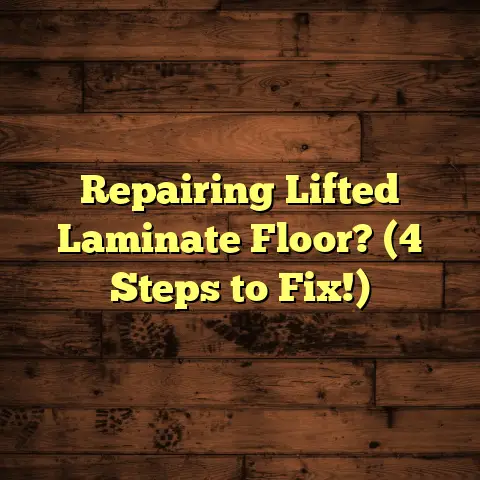Choose Right Flooring: Home Guide? (1 Pro’s Secret!)
Did you know that nearly 70% of homeowners regret their flooring choices within just five years of installation? Ouch. That’s a statistic that keeps me up at night, because nobody should be stuck with floors they hate!
Ready to dive in? Let’s get started!
Section 1: Understanding Flooring Types
Alright, let’s get down to brass tacks. There’s a TON of flooring options out there, and it can feel overwhelming. I’m going to break down the most common types, giving you the lowdown on what makes each one tick.
1.1 Overview of Flooring Options
-
Hardwood: The classic choice! Think solid planks of oak, maple, or walnut. It adds warmth and value to any home.
-
Laminate: A budget-friendly alternative that mimics the look of hardwood using a photographic layer.
-
Vinyl: Super versatile and comes in planks (LVP), sheets, or tiles. Waterproof and great for high-moisture areas.
-
Tile: Durable and water-resistant, perfect for bathrooms, kitchens, and even entryways. Think ceramic, porcelain, or stone.
-
Carpet: Soft and cozy underfoot, offering warmth and sound absorption. Comes in various piles, fibers, and colors.
1.2 Pros and Cons of Each Flooring Type
To make it easier to compare, here’s a handy table:
| Flooring Type | Pros | Cons |
|---|---|---|
| Hardwood | Timeless beauty, adds value, durable (can be refinished), warm and inviting. | Can be expensive, susceptible to scratches and water damage, requires specialized cleaning. |
| Laminate | Affordable, easy to install, scratch-resistant, wide variety of styles. | Doesn’t add as much value as hardwood, not waterPROOF (water-resistant), can sound hollow. |
| Vinyl | Waterproof, durable, easy to clean, affordable, comfortable underfoot. | Can look less luxurious than hardwood or tile, can be susceptible to dents and gouges, some types may off-gas VOCs. |
| Tile | Extremely durable, water-resistant, easy to clean, great for high-traffic areas. | Can be cold underfoot, hard surface, grout requires maintenance, can be expensive to install. |
| Carpet | Soft and comfortable, warm, absorbs sound, hides dirt and stains well. | Can trap allergens, requires regular cleaning, susceptible to stains and wear, not ideal for high-moisture areas. |
Think about that table. What stands out to you?
Section 2: Factors to Consider When Choosing Flooring
Okay, now that you’ve got a handle on the different types, let’s talk about the things that really matter when making your choice.
2.1 Lifestyle Considerations
Your lifestyle plays a HUGE role in determining the best flooring for your home.
-
Household Size: A large family with kids and pets will need something super durable and easy to clean, like vinyl or tile.
-
Pets: Scratch-resistant options like laminate or vinyl are your best friends here. Avoid softwoods like pine, which are easily damaged.
-
Kids: Durability and stain resistance are key. Carpet tiles are a great option because you can replace individual tiles if they get damaged.
Let’s paint a picture. Imagine a family with two golden retrievers and three energetic kids. Would delicate hardwood be the best choice? Probably not!
2.2 Climate and Environment
Where you live matters!
-
Humidity: High humidity can wreak havoc on hardwood floors, causing them to expand and contract. In these areas, vinyl or tile are better choices.
-
Cold Climates: Carpet can provide extra warmth and insulation in colder climates.
-
Sun Exposure: Intense sunlight can fade some flooring materials, especially darker hardwoods and laminates. Consider UV-resistant options or window treatments.
I once worked on a beach house where the homeowners insisted on hardwood. Within a year, the humidity had caused significant warping. We ended up replacing it with luxury vinyl plank, and they couldn’t be happier.
2.3 Aesthetic Preferences
Of course, you want your floors to look good!
-
Color: Lighter colors can make a room feel larger and brighter, while darker colors add warmth and drama.
-
Texture: Smooth floors feel modern, while textured floors add character and hide imperfections.
-
Design Trends: Keep up with the latest trends, but don’t sacrifice your personal style. Timeless choices are always a safe bet.
Think about the overall style of your home. Do you have a modern, minimalist aesthetic? Or are you more drawn to a cozy, rustic vibe? Your flooring should complement your existing decor.
Section 3: The Importance of Functionality
It’s not just about looks! Your floors need to work for you.
3.1 Durability and Maintenance
-
Durability: How well will the flooring stand up to daily wear and tear? Consider the traffic in each area of your home.
-
Ease of Cleaning: How easy is it to clean spills and messes? This is especially important in kitchens and bathrooms.
-
Long-Term Maintenance: Will you need to refinish the floors every few years? Or can you simply sweep and mop?
I always tell my clients to think about their cleaning habits. If you’re not a fan of mopping, maybe tile isn’t the best choice for you!
3.2 Safety Features
-
Slip Resistance: Choose slip-resistant flooring for areas prone to moisture, like bathrooms and kitchens.
-
Allergens: If you have allergies, avoid carpet, which can trap dust and allergens. Opt for hard surfaces that are easy to clean.
-
VOCs: Some flooring materials, like vinyl, can release volatile organic compounds (VOCs). Look for low-VOC options to improve indoor air quality.
Safety is paramount. Especially if you have young children or elderly family members.
Section 4: Budgeting for Your Flooring Project
Let’s talk money. Flooring can be a significant investment, so it’s important to have a realistic budget.
4.1 Cost Breakdown
Here’s a general idea of the costs per square foot (including materials and installation):
- Carpet: $3 – $10
- Laminate: $3 – $12
- Vinyl: $4 – $15
- Tile: $5 – $20+
- Hardwood: $8 – $25+
These are just estimates, and prices can vary depending on the quality of the materials and the complexity of the installation.
4.2 Budgeting Tips
-
Get Multiple Quotes: Don’t settle for the first quote you receive. Get at least three estimates from different contractors.
-
Factor in Hidden Costs: Don’t forget to budget for things like removing old flooring, subfloor repairs, and trim.
-
Consider DIY Installation: If you’re handy, you can save money by installing the flooring yourself. However, be sure you have the necessary skills and tools.
I’ve seen too many homeowners get blindsided by unexpected costs. Planning is KEY!
Section 5: The Secret of the Pros
Alright, folks, this is what you’ve been waiting for! I’m about to reveal the ONE secret that separates the flooring pros from the amateurs.
5.1 Introduction to the Pro’s Secret
The pro’s secret isn’t some magic trick or fancy tool. It’s simply this: We understand the importance of sample testing and personalized advice.
5.2 The Pro’s Secret Explained
Here’s what that means in practice:
-
Sample Testing: Before making a final decision, get samples of your top flooring choices and test them in your home. Spill things on them, scratch them, and see how they look in different lighting conditions.
-
Personalized Advice: Don’t rely solely on online reviews or sales pitches. Consult with a flooring expert who can assess your specific needs and recommend the best options for your home.
I can’t tell you how many times I’ve saved clients from making costly mistakes simply by encouraging them to test samples and get a professional opinion.
One of my clients was dead-set on installing dark hardwood in her living room. I convinced her to get a sample and leave it in the room for a few days. She quickly realized that the dark color made the room feel smaller and showed every speck of dust. She ended up going with a lighter color, and she’s so glad she did!
Section 6: Making the Final Decision
You’ve done your research, considered your options, and learned the pro’s secret. Now it’s time to make a final decision.
6.1 Steps to Finalize Your Choice
-
Visit Showrooms: Go to local flooring stores and see the different options in person.
-
Obtain Samples: Get samples of your top choices and test them in your home.
-
Consult with Installation Experts: Talk to a professional installer about the installation process and any potential challenges.
-
Get a Written Quote: Make sure you have a detailed written quote that includes all costs.
6.2 Visualizing the Final Look
-
Design Software: Use online design tools or apps to visualize how different flooring choices will look in your home.
-
Mood Boards: Create a mood board with paint colors, furniture, and flooring samples to get a sense of the overall aesthetic.
-
Trust Your Gut: Ultimately, the best flooring choice is the one that you love and that fits your lifestyle and budget.
Don’t be afraid to take your time and make sure you’re making the right decision.
Conclusion
Choosing the right flooring is a big decision, but it doesn’t have to be overwhelming. By understanding the different types of flooring, considering your lifestyle and budget, and following the pro’s secret, you can make a choice that you’ll be happy with for years to come.
Remember, the pro’s secret is all about sample testing and personalized advice. Don’t skip these crucial steps!
Call to Action
Now it’s your turn! Explore your options, visit local flooring stores, and engage with professionals to find the perfect flooring solution for your home.
Good luck, and happy flooring!





